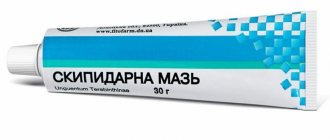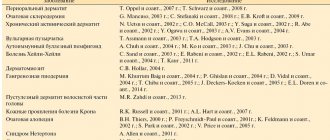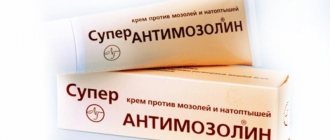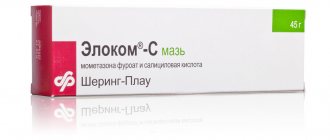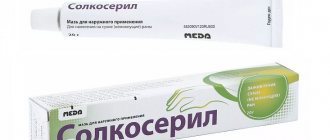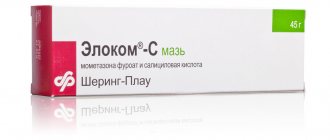Compound
Beloderm cream contains the active ingredient betamethasone dipropionate .
As excipients, the product contains sodium dihydrogen phosphate monohydrate, chlorocresol, petroleum jelly, phosphoric acid, cetostearyl alcohol, macrogol cetostearate, sodium hydroxide, mineral oil, water. Beloderm ointment contains the active ingredient betamethasone dipropionate . The preparation also contains petroleum jelly and mineral oil as excipients.
pharmachologic effect
The drug has vasoconstrictor , antiexudative , antiproliferative , antiallergic , antipruritic , anti-inflammatory effects .
After the drug is applied to the skin, it has a pronounced effect at the site of the inflammatory process, reduces the severity of both a number of symptoms and subjective sensations.
The active ingredient betamethasone dipropionate is a synthetically produced adrenocorticosteroid. It has a more pronounced corticosteroid effect, as well as a minor mineralocorticoid effect.
After using the product, there is a decrease in the production and release of histamine, lysosomal enzymes, and prostaglandins.
Also, under the influence of glucocorticosteroids, plasma extravasation decreases and the development of edema stops.
Under the influence of Beloderm, the effect of magrophages and lymphokines of target cells is reduced, and the active access of sensitized macrophages and T-lymphocytes to target cells is prevented. The medicine helps reduce the rate of development of dermatitis of allergic origin .
Description of the drug BELODERM®
GKS. Suppresses the functions of leukocytes and tissue macrophages. Limits the migration of leukocytes to the area of inflammation. It disrupts the ability of macrophages to phagocytose, as well as to form interleukin-1. Helps stabilize lysosomal membranes, thereby reducing the concentration of proteolytic enzymes in the area of inflammation. Reduces capillary permeability due to the release of histamine. Suppresses fibroblast activity and collagen formation.
Inhibits the activity of phospholipase A2, which leads to suppression of the synthesis of prostaglandins and leukotrienes. Suppresses the release of COX (mainly COX-2), which also helps to reduce the production of prostaglandins.
Reduces the number of circulating lymphocytes (T- and B-cells), monocytes, eosinophils and basophils due to their movement from the vascular bed into the lymphoid tissue; suppresses the formation of antibodies.
Betamethasone suppresses the pituitary release of ACTH and β-lipotropin, but does not reduce the level of circulating β-endorphin. Inhibits the secretion of TSH and FSH.
When directly applied to blood vessels, it has a vasoconstrictor effect.
Betamethasone has a pronounced dose-dependent effect on the metabolism of carbohydrates, proteins and fats. Stimulates gluconeogenesis, promotes the uptake of amino acids by the liver and kidneys and increases the activity of gluconeogenesis enzymes. In the liver, betamethasone enhances the deposition of glycogen, stimulating the activity of glycogen synthetase and the synthesis of glucose from protein metabolism products. An increase in blood glucose levels activates the release of insulin.
Betamethasone inhibits the uptake of glucose into fat cells, which leads to activation of lipolysis. However, due to increased insulin secretion, lipogenesis is stimulated, which promotes fat accumulation.
Retains sodium ions and water in the body, stimulates the excretion of potassium ions, reduces calcium absorption from the gastrointestinal tract, washes calcium ions from bones, increases calcium excretion by the kidneys.
It has a catabolic effect in lymphoid and connective tissue, muscles, adipose tissue, skin, bone tissue. Osteoporosis and Itsenko-Cushing syndrome are the main factors limiting long-term GCS therapy. As a result of the catabolic effect, growth suppression in children is possible.
In high doses, betamethasone can increase the excitability of brain tissue and help lower the seizure threshold. Stimulates excess production of hydrochloric acid and pepsin in the stomach, which leads to the development of peptic ulcers.
When used systemically, the therapeutic activity of betamethasone is due to anti-inflammatory, antiallergic, immunosuppressive and antiproliferative effects.
When applied externally and locally, the therapeutic activity of betamethasone is due to its anti-inflammatory, antiallergic and antiexudative (due to the vasoconstrictor effect) effect.
Its anti-inflammatory activity is 30 times higher than hydrocortisone, but does not have mineralocorticoid activity. The presence of a fluorine atom in the molecule enhances the anti-inflammatory activity of betamethasone.
Betamethasone in the form of dipropionate is characterized by long-lasting action.
Indications for use
Hormonal ointment and cream are used for the following diseases and conditions:
- a number of types of dermatitis - allergic, atopic, contact; other forms of non-allergic dermatitis;
- neurodermatitis;
- consequences of insect bites;
- different forms of eczema ;
- psoriasis;
- discoid lupus erythematosus;
- bullous dermatoses ;
- exudative erythema multiforme ;
- manifestations of skin itching ;
- lichen planus.
Nosological classification (ICD-10)
- L13.9 Bullous changes, unspecified
- L20 Atopic dermatitis
- L23 Allergic contact dermatitis
- L24 Simple irritant contact dermatitis
- L25 Contact dermatitis, unspecified
- L29 Itching
- L30.9 Dermatitis, unspecified
- L40 Psoriasis
- L43 Lichen ruber flatus
- L51 Erythema multiforme
- L56.2 Photocontact dermatitis
- L56.3 Solar urticaria
- L58 Radiation radiation dermatitis
- L93 Lupus erythematosus
- W57 Bite or sting by non-venomous insects and other non-venomous arthropods
Contraindications
Beloderm should not be used for the following diseases and conditions:
- intolerance to the active ingredient and additional components;
- phlebeurysm;
- tuberculosis of the skin;
- perioral dermatitis;
- rosacea;
- the presence of a pronounced reaction after vaccination;
- other infectious skin diseases associated with exposure to bacteria and fungi.
The cream should absolutely not be applied to the periorbital area.
A number of relative contraindications for the use of the drug are also determined. In particular, Beloderm cream should not be applied to the face if there are lesions for more than one week. In case of liver failure, only small doses of the drug can be used for a short period of time, and a bandage should not be used. Care should be taken to apply the product to areas where there are body folds and natural occlusion , as the risk of systemic influence increases.
It is used very carefully for the treatment of children due to the increased absorption of betamethasone in children. Under no circumstances should cream be used under diapers.
Beloderm ointment for external use 0.05% 40 g tube 1 pc. in Moscow
Pharmacological action: Interacts with specific receptors in the cytoplasm of the cell, the resulting complex penetrates the cell nucleus, binds to DNA and stimulates the synthesis of mRNA, inducing the formation of proteins, incl. lipocortin, mediating cellular effects. In some cells (for example, in lymphocytes) it causes suppression of mRNA. Lipocortin inhibits phospholipase A2, blocks the liberation of arachidonic acid and the biosynthesis of endoperoxides, PGs, and leukotrienes (which contribute to the development of inflammation, allergies and other pathological processes).
Affects all phases of inflammation. The anti-inflammatory effect is due to many factors. One of the leading ones is inhibition of phospholipase A2 with subsequent inhibition of the formation of pro-inflammatory mediators - PG and leukotrienes. In addition, it stabilizes cell membranes, incl. membranes of lysosomes, prevents the release of lysosomal enzymes and reduces their concentration at the site of inflammation. Inhibits the migration of neutrophils and macrophages to the site of inflammation and their phagocytic activity. Improves microcirculation, reduces vascular permeability, causes vasoconstriction of capillaries, and reduces fluid exudation.
The antiallergic effect develops as a result of a decrease in the synthesis and secretion of allergy mediators, inhibition of the release of histamine and other biologically active substances from sensitized mast cells and basophils, a decrease in the number of circulating basophils, suppression of the proliferation of lymphoid and connective tissue, a decrease in the number of T- and B-lymphocytes, mast cells , reducing the sensitivity of effector cells to allergy mediators, suppressing antibody formation, changing the body’s immune response.
The immunosuppressive effect is associated with suppression of the activity of T- and B-lymphocytes, as well as inhibition of the release of cytokines (interleukin-1, interleukin-2, interferon-gamma) from leukocytes and macrophages.
Antishock and antitoxic effects are associated with an increase in blood pressure (due to an increase in the amount of circulating catecholamines, restoration of the sensitivity of adrenergic receptors to catecholamines and vasoconstriction), activation of liver enzymes involved in the metabolism of endo- and xenobiotics.
It has a pronounced effect on all types of exchange. Stimulates gluconeogenesis in the liver, increases blood glucose levels (glucosuria is possible). Accelerates protein catabolism, especially in muscle tissue. Causes a redistribution of fat: increases lipolysis in the tissues of the extremities, promotes the accumulation of fat mainly in the face (moon face), neck, and shoulder girdle. Retains Na+ and water, stimulates the excretion of K+, increases the excretion of Ca+.
With long-term use, it suppresses the function of the hypothalamus-pituitary-adrenal system.
After parenteral (i.m.) and enteral administration, it is rapidly absorbed - the maximum effect (when taken orally) develops after 1–2 hours.
When using a combination of salts in one preparation, betamethasone disodium phosphate is well absorbed from the injection site and has a rapid effect; betamethasone dipropionate has a slower absorption, but provides a long-lasting effect.
When instilled into the conjunctival sac, it penetrates into the intraocular fluid, cornea, iris, choroid, ciliary body, and retina. Systemic absorption may be significant only when used in high doses or with prolonged use in children.
When applied locally to the skin, the intensity of absorption depends on a number of factors: the solvent (polypropylene components improve diffusion), the state of the epidermal barrier (inflammation and skin diseases increase absorption).
Binds to plasma proteins. Easily passes histohematic barriers, including placental ones. Partially excreted in breast milk. Biotransformed mainly in the liver, the resulting metabolites are inactive. Excreted by the kidneys.
Carcinogenicity, mutagenicity, effect on fertility
Long-term animal studies have not been conducted to evaluate the potential carcinogenicity or effects on fertility of topical betamethasone. Betamethasone was genotoxic in vitro
in the chromosomal aberration test on human lymphocytes (with metabolic activation) and
in vivo
in the micronucleus test on mouse bone marrow.
Side effects
In the process of using a product with the active substance betamethasone externally, a reduction in collagen, as well as a number of other changes in the skin, is possible. skin atrophy , stretch marks , folliculitis , telangiectasia , hypertrichosis , and ecchymosis may appear .
Patients who practice long-term treatment should note that with long-term use of Beloderm, hyperpigmentation , skin depigmentation , itching and skin rash .
With prolonged use of Beloderm, the functions of the sweat glands may decrease. Secondary skin infection may occur as a consequence of immunosuppression. If a standard treatment regimen is followed, side effects are unlikely. The risk of their occurrence increases if treatment is carried out over a long period of time and in large doses. If reactions are observed on the skin, use of Beloderm should be stopped immediately.
Beloderm ointment for external use 0.05% 15 g tube 1 pc. In Ekaterinburg
Pharmacological action: Interacts with specific receptors in the cytoplasm of the cell, the resulting complex penetrates the cell nucleus, binds to DNA and stimulates the synthesis of mRNA, inducing the formation of proteins, incl. lipocortin, mediating cellular effects. In some cells (for example, in lymphocytes) it causes suppression of mRNA. Lipocortin inhibits phospholipase A2, blocks the liberation of arachidonic acid and the biosynthesis of endoperoxides, PGs, and leukotrienes (which contribute to the development of inflammation, allergies and other pathological processes).
Affects all phases of inflammation. The anti-inflammatory effect is due to many factors. One of the leading ones is inhibition of phospholipase A2 with subsequent inhibition of the formation of pro-inflammatory mediators - PG and leukotrienes. In addition, it stabilizes cell membranes, incl. membranes of lysosomes, prevents the release of lysosomal enzymes and reduces their concentration at the site of inflammation. Inhibits the migration of neutrophils and macrophages to the site of inflammation and their phagocytic activity. Improves microcirculation, reduces vascular permeability, causes vasoconstriction of capillaries, and reduces fluid exudation.
The antiallergic effect develops as a result of a decrease in the synthesis and secretion of allergy mediators, inhibition of the release of histamine and other biologically active substances from sensitized mast cells and basophils, a decrease in the number of circulating basophils, suppression of the proliferation of lymphoid and connective tissue, a decrease in the number of T- and B-lymphocytes, mast cells , reducing the sensitivity of effector cells to allergy mediators, suppressing antibody formation, changing the body’s immune response.
The immunosuppressive effect is associated with suppression of the activity of T- and B-lymphocytes, as well as inhibition of the release of cytokines (interleukin-1, interleukin-2, interferon-gamma) from leukocytes and macrophages.
Antishock and antitoxic effects are associated with an increase in blood pressure (due to an increase in the amount of circulating catecholamines, restoration of the sensitivity of adrenergic receptors to catecholamines and vasoconstriction), activation of liver enzymes involved in the metabolism of endo- and xenobiotics.
It has a pronounced effect on all types of exchange. Stimulates gluconeogenesis in the liver, increases blood glucose levels (glucosuria is possible). Accelerates protein catabolism, especially in muscle tissue. Causes a redistribution of fat: increases lipolysis in the tissues of the extremities, promotes the accumulation of fat mainly in the face (moon face), neck, and shoulder girdle. Retains Na+ and water, stimulates the excretion of K+, increases the excretion of Ca+.
With long-term use, it suppresses the function of the hypothalamus-pituitary-adrenal system.
After parenteral (i.m.) and enteral administration, it is rapidly absorbed - the maximum effect (when taken orally) develops after 1–2 hours.
When using a combination of salts in one preparation, betamethasone disodium phosphate is well absorbed from the injection site and has a rapid effect; betamethasone dipropionate has a slower absorption, but provides a long-lasting effect.
When instilled into the conjunctival sac, it penetrates into the intraocular fluid, cornea, iris, choroid, ciliary body, and retina. Systemic absorption may be significant only when used in high doses or with prolonged use in children.
When applied locally to the skin, the intensity of absorption depends on a number of factors: the solvent (polypropylene components improve diffusion), the state of the epidermal barrier (inflammation and skin diseases increase absorption).
Binds to plasma proteins. Easily passes histohematic barriers, including placental ones. Partially excreted in breast milk. Biotransformed mainly in the liver, the resulting metabolites are inactive. Excreted by the kidneys.
Carcinogenicity, mutagenicity, effect on fertility
Long-term animal studies have not been conducted to evaluate the potential carcinogenicity or effects on fertility of topical betamethasone. Betamethasone was genotoxic in vitro
in the chromosomal aberration test on human lymphocytes (with metabolic activation) and
in vivo
in the micronucleus test on mouse bone marrow.
Instructions for use Beloderm (Method and dosage)
If Beloderm cream or ointment is prescribed, the instructions for use by the patient must be carefully followed.
The instructions for the cream provide for external use only. The ointment or cream should be easily rubbed into dry, cleansed skin. This procedure should be carried out up to 3 times daily, but in most cases, for effective treatment it is enough to treat the affected areas 1-2 times a day. Apply the cream in a thin layer to the area being treated. If the patient missed applying the cream, then it should be applied as soon as the person remembers. In this case, the usual dose of the drug is used.
When using occlusive dressings, the systemic effect of the drug is enhanced, so they are not recommended for use. Treatment lasts no more than 4 weeks. If it is necessary to ensure the prevention of relapses in chronic diseases, the application of ointment or cream should continue after the disappearance of severe symptoms.
During treatment, it is important to carefully monitor the functioning of the hypothalamic-pituitary-adrenal system. If signs of inhibition of this system appear, Beloderm should be discontinued. It is important to avoid getting the product into your eyes.
The cream is advisable to use for the treatment of skin lesions that have an acute course. The ointment is applied to dry, flaky skin for the treatment of subacute and chronic dermatoses when occlusive action is required.
Directions for use and doses
Externally, apply a thin layer to the affected area of the skin, lightly rubbing, 2 times a day. On areas with thicker skin (elbows, palms, feet), as well as places from which the drug is easily washed off, it can be applied more often. The duration of a continuous course of treatment is usually no more than 4 weeks. To prevent relapses in the treatment of chronic diseases, treatment should be continued for some time after all symptoms disappear. Therapy may be repeated several times throughout the year.
In the form of a cream, the drug is intended for the treatment of acute, incl. weeping, skin lesions. The ointment is used for the treatment of subacute and chronic dermatoses, incl. dry, lichenified and scaly lesions or in cases where an occlusive action is necessary.
Overdose
Systemic overdose may occur if the drug is applied in large quantities over a large area of skin, while occlusive coatings are used. Cases of chronic overdose have been recorded when using the product for more than three weeks. Symptoms of overdose are inhibition of the functions of the hypothalamus-pituitary-adrenal system .
As a result, children experience growth retardation and intracranial hypertension ( headaches , swelling and pulsation of the crown), Cushing's syndrome, and impaired glucose metabolism. If such signs occur, you should immediately stop treatment with the drug and ensure the restoration of water-salt balance. Next, symptomatic treatment is practiced.
Beloderm ointment for external use 0.05% 15 g tube 1 pc. in Kirov
Pharmacological action: Interacts with specific receptors in the cytoplasm of the cell, the resulting complex penetrates the cell nucleus, binds to DNA and stimulates the synthesis of mRNA, inducing the formation of proteins, incl. lipocortin, mediating cellular effects. In some cells (for example, in lymphocytes) it causes suppression of mRNA. Lipocortin inhibits phospholipase A2, blocks the liberation of arachidonic acid and the biosynthesis of endoperoxides, PGs, and leukotrienes (which contribute to the development of inflammation, allergies and other pathological processes).
Affects all phases of inflammation. The anti-inflammatory effect is due to many factors. One of the leading ones is inhibition of phospholipase A2 with subsequent inhibition of the formation of pro-inflammatory mediators - PG and leukotrienes. In addition, it stabilizes cell membranes, incl. membranes of lysosomes, prevents the release of lysosomal enzymes and reduces their concentration at the site of inflammation. Inhibits the migration of neutrophils and macrophages to the site of inflammation and their phagocytic activity. Improves microcirculation, reduces vascular permeability, causes vasoconstriction of capillaries, and reduces fluid exudation.
The antiallergic effect develops as a result of a decrease in the synthesis and secretion of allergy mediators, inhibition of the release of histamine and other biologically active substances from sensitized mast cells and basophils, a decrease in the number of circulating basophils, suppression of the proliferation of lymphoid and connective tissue, a decrease in the number of T- and B-lymphocytes, mast cells , reducing the sensitivity of effector cells to allergy mediators, suppressing antibody formation, changing the body’s immune response.
The immunosuppressive effect is associated with suppression of the activity of T- and B-lymphocytes, as well as inhibition of the release of cytokines (interleukin-1, interleukin-2, interferon-gamma) from leukocytes and macrophages.
Antishock and antitoxic effects are associated with an increase in blood pressure (due to an increase in the amount of circulating catecholamines, restoration of the sensitivity of adrenergic receptors to catecholamines and vasoconstriction), activation of liver enzymes involved in the metabolism of endo- and xenobiotics.
It has a pronounced effect on all types of exchange. Stimulates gluconeogenesis in the liver, increases blood glucose levels (glucosuria is possible). Accelerates protein catabolism, especially in muscle tissue. Causes a redistribution of fat: increases lipolysis in the tissues of the extremities, promotes the accumulation of fat mainly in the face (moon face), neck, and shoulder girdle. Retains Na+ and water, stimulates the excretion of K+, increases the excretion of Ca+.
With long-term use, it suppresses the function of the hypothalamus-pituitary-adrenal system.
After parenteral (i.m.) and enteral administration, it is rapidly absorbed - the maximum effect (when taken orally) develops after 1–2 hours.
When using a combination of salts in one preparation, betamethasone disodium phosphate is well absorbed from the injection site and has a rapid effect; betamethasone dipropionate has a slower absorption, but provides a long-lasting effect.
When instilled into the conjunctival sac, it penetrates into the intraocular fluid, cornea, iris, choroid, ciliary body, and retina. Systemic absorption may be significant only when used in high doses or with prolonged use in children.
When applied locally to the skin, the intensity of absorption depends on a number of factors: the solvent (polypropylene components improve diffusion), the state of the epidermal barrier (inflammation and skin diseases increase absorption).
Binds to plasma proteins. Easily passes histohematic barriers, including placental ones. Partially excreted in breast milk. Biotransformed mainly in the liver, the resulting metabolites are inactive. Excreted by the kidneys.
Carcinogenicity, mutagenicity, effect on fertility
Long-term animal studies have not been conducted to evaluate the potential carcinogenicity or effects on fertility of topical betamethasone. Betamethasone was genotoxic in vitro
in the chromosomal aberration test on human lymphocytes (with metabolic activation) and
in vivo
in the micronucleus test on mouse bone marrow.
special instructions
Long-term use is not recommended for the treatment of facial skin lesions due to the likelihood of developing acne , perioral dermatitis , and rosacea .
Do not allow the cream or ointment to come into contact with the mucous membrane of the eyes, as this can provoke the development of glaucoma , cataracts , and fungal eye diseases.
You cannot use the medicine for a long time to treat areas of the body with natural occlusion.
If a bacterial or fungal infection develops, an antibacterial or antifungal drug should be additionally used for treatment.
Does not affect the ability to concentrate and drive.
Beloderm ointment for external use 0.05% 40 g tube 1 pc. in Kursk
Pharmacological action: Interacts with specific receptors in the cytoplasm of the cell, the resulting complex penetrates the cell nucleus, binds to DNA and stimulates the synthesis of mRNA, inducing the formation of proteins, incl. lipocortin, mediating cellular effects. In some cells (for example, in lymphocytes) it causes suppression of mRNA. Lipocortin inhibits phospholipase A2, blocks the liberation of arachidonic acid and the biosynthesis of endoperoxides, PGs, and leukotrienes (which contribute to the development of inflammation, allergies and other pathological processes).
Affects all phases of inflammation. The anti-inflammatory effect is due to many factors. One of the leading ones is inhibition of phospholipase A2 with subsequent inhibition of the formation of pro-inflammatory mediators - PG and leukotrienes. In addition, it stabilizes cell membranes, incl. membranes of lysosomes, prevents the release of lysosomal enzymes and reduces their concentration at the site of inflammation. Inhibits the migration of neutrophils and macrophages to the site of inflammation and their phagocytic activity. Improves microcirculation, reduces vascular permeability, causes vasoconstriction of capillaries, and reduces fluid exudation.
The antiallergic effect develops as a result of a decrease in the synthesis and secretion of allergy mediators, inhibition of the release of histamine and other biologically active substances from sensitized mast cells and basophils, a decrease in the number of circulating basophils, suppression of the proliferation of lymphoid and connective tissue, a decrease in the number of T- and B-lymphocytes, mast cells , reducing the sensitivity of effector cells to allergy mediators, suppressing antibody formation, changing the body’s immune response.
The immunosuppressive effect is associated with suppression of the activity of T- and B-lymphocytes, as well as inhibition of the release of cytokines (interleukin-1, interleukin-2, interferon-gamma) from leukocytes and macrophages.
Antishock and antitoxic effects are associated with an increase in blood pressure (due to an increase in the amount of circulating catecholamines, restoration of the sensitivity of adrenergic receptors to catecholamines and vasoconstriction), activation of liver enzymes involved in the metabolism of endo- and xenobiotics.
It has a pronounced effect on all types of exchange. Stimulates gluconeogenesis in the liver, increases blood glucose levels (glucosuria is possible). Accelerates protein catabolism, especially in muscle tissue. Causes a redistribution of fat: increases lipolysis in the tissues of the extremities, promotes the accumulation of fat mainly in the face (moon face), neck, and shoulder girdle. Retains Na+ and water, stimulates the excretion of K+, increases the excretion of Ca+.
With long-term use, it suppresses the function of the hypothalamus-pituitary-adrenal system.
After parenteral (i.m.) and enteral administration, it is rapidly absorbed - the maximum effect (when taken orally) develops after 1–2 hours.
When using a combination of salts in one preparation, betamethasone disodium phosphate is well absorbed from the injection site and has a rapid effect; betamethasone dipropionate has a slower absorption, but provides a long-lasting effect.
When instilled into the conjunctival sac, it penetrates into the intraocular fluid, cornea, iris, choroid, ciliary body, and retina. Systemic absorption may be significant only when used in high doses or with prolonged use in children.
When applied locally to the skin, the intensity of absorption depends on a number of factors: the solvent (polypropylene components improve diffusion), the state of the epidermal barrier (inflammation and skin diseases increase absorption).
Binds to plasma proteins. Easily passes histohematic barriers, including placental ones. Partially excreted in breast milk. Biotransformed mainly in the liver, the resulting metabolites are inactive. Excreted by the kidneys.
Carcinogenicity, mutagenicity, effect on fertility
Long-term animal studies have not been conducted to evaluate the potential carcinogenicity or effects on fertility of topical betamethasone. Betamethasone was genotoxic in vitro
in the chromosomal aberration test on human lymphocytes (with metabolic activation) and
in vivo
in the micronucleus test on mouse bone marrow.
Analogs
Level 4 ATC code matches:
Gistan-N
Sinalar
Avecourt
Mesoderm
Momederm
Betazon
Silkaren
Elokom
Flucinar
Sinaflan
Celestoderm
Cutivate
Advantan
Betamethasone
Mometasone Furoate
Uniderm
Momat
The following analogues of Beloderm are available: Celestoderm-B , Akriderm , Celeston . These drugs have a similar effect, but they can be used for specific diseases only after permission from a specialist.
Reviews about Beloderm
There are different reviews about Beloderm on the network. Patients use it for various skin diseases. Reviews of ointments and creams often indicate that the product can reduce the severity of symptoms of diseases after just a few applications. It is also noted that Beloderm helps prevent remissions of some chronic diseases. However, this drug should not be used independently and uncontrolled, since its use without a doctor’s prescription often blurs the overall picture of the disease, which makes it difficult to establish a diagnosis and prescribe the correct treatment regimen.
Beloderm price, where to buy
The price of Beloderm ointment (15 g) ranges from 120 to 140 rubles. Cream (30 g) can be bought at a price of 200 to 240 rubles. Beloderm price in Ukraine - from 60 UAH. per pack of cream or ointment 30 g.
- Online pharmacies in RussiaRussia
- Online pharmacies in UkraineUkraine
ZdravCity
- Beloderm Express spray for external use.
approx. 0.05% 20mlBELUPO, Medicines and cosmetics d.d. RUB 335 order - Beloderm cream 0.05% 15gBelupo
125 rub. order
- Beloderm cream 0.05% 40gBELUPO, Medicines and cosmetics d.d.
RUB 278 order
- Beloderm ointment 0.05% 30gBelupo
RUB 187 order
- Beloderm cream 0.05% 30gBelupo
RUB 191 order
Pharmacy Dialogue
- Beloderm ointment (tube 0.05% 30g)Belupo
RUB 192 order
- Beloderm cream (tube 0.05% 40g)Belupo
RUB 256 order
- Beloderm Express (spray 0.05% 50ml)Belupo
RUR 494 order
- Beloderm cream (tube 0.05% 30g)Belupo
184 RUR order
- Beloderm ointment (tube 0.05% 40g)Belupo
RUB 251 order
show more
Pharmacy24
- Beloderm 0.05% 30 g Belupo ointment, liquids and cosmetics d.d., Croatia
103 UAH.order - Beloderm 0.05% 30 g Belupo cream, Liki and cosmetics d.d., Croatia
103 UAH order
- Beloderm 0.05% 15g tube cream for external use
79 UAH order
